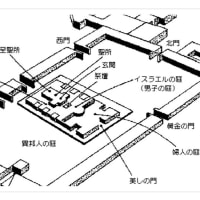38章 ゴグとイスラエルの回復(38:1-39:29)
先に、エゼキエル書は、黙示録と深く関係していることをお話しました。使徒ヨハネは、エゼキエル書にある様々なイメージを使いながら、黙示録を描いています。以前、ケルビムと玉座におられる神のイメージが使われているお話をしましたが、この38章のゴグとマゴグの戦争のイメージも使われています。そのような意味で、今日の箇所も、私たちに深い関りがあることを覚えたいのです。
1.ゴグとマゴグの預言
まずゴグは、マゴグという国の王です。別にメシュクとトバルの地の大首長とも呼ばれています(2節)。マゴグにしろ、メシュクとトバルにしろ、具体的に、それはどこを指しているのかよくわかっていません。ただエゼキエルが、これらの民族を「北の果て」(6節)に住む者として語っているところから、現在ロシアとして知られる地域に住む人々、古代の文献ではスクテヤ人として知られる民族ではないかと考えられています。
エゼキエルが生まれた頃、西南アジアは北方の遊牧民による脅威にさらされていました。エゼキエルはそのスクテヤ人が再び侵入すると預言しているのです。彼らは神の民に対して総攻撃をかけてくる、と。しかし、17節以降、神に用いられたゴグは、滅ぼされることが記されています。バビロンの王ネブカドネツァルが、神の民を罰するために、神によって用いられましたが、それによって彼が奢り高ぶると、ペルシアによって滅ぼされてしまったのと同じです。攻撃者ゴグもまた高慢によって滅ぼされてしまうというわけです。
問題は、このゴグとマゴグの預言が、どの時代の、どんな出来事を語っているのかです。これまでは、バビロン捕囚からの回復を語ってきていますから、そうなると捕囚期以降に起こる新たな脅威を預言していることになります。しかし、当てはまるような史実はありません。つまりこの38章と後に続く39章を地上の歴史に当てはめて解釈するのは難しいのです。一説にBC7世紀頃に活躍したリディアの王ギゲスのことではないかと考える説もありますが、苦しい解釈です。となれば、預言書の二重預言という性質を踏まえて、ここは、終末的な意味を持った、終末預言と解釈するのがよいとなります。
2.エゼキエル書と黙示録
そしてそのように積極的に考える根拠はと聞かれると、それは、黙示録の著者ヨハネが、そのように解釈しているからだと言えます。つまり歴史的に著名な神学者がそう考えたのではない、あるいは福井牧師が自説を唱えたというのではない、イエスの弟子ヨハネが、黙示録にこの個所を引用して、終末的預言を語っているからです(20:7-9)。
そこでヨハネの解釈を理解しておきましょう。ヨハネは、黙示録21章から終末の新しい天と新しい地の幻について語っています。その神の国が現れる直前の出来事として、悪魔的な勢力が、神の民に対して攻撃を加える様子を、この箇所のことばゴグ、マゴグ、そしてそのイメージを使いながら語っているのです。実際、8節、ゴグに攻められるこの国は、「国々の民の中から集められた者たちの国」です。つまり私たちの歴史にこのような国は起こっていない。もし起こっているとしたら、あらゆる民族に伝えられたキリストの福音を受け入れた人々の集まり、普遍的なキリスト教会と言うべきでしょう。さらにエゼキエル書の38:20に描かれている状況「山々はくつがえり、崖は落ち、全ての城壁は地に倒れる」は、ある意味で、ヨハネが引用してもあまり違和感のない、終末的な世の終わりをイメージさせる内容となっています。なおヨハネは黙示録21章以降に、新天新地、永遠の神の都の幻を書き記していますが、まさにそれは、エゼキエル書40章以降に描かれた第三神殿の幻と重なっています。ヨハネの解釈の妥当性を思わされるところです。
そこでこの38章は、後の39章に続いて何を語っているのか?簡単に言えば、ゴグが、世界中から集められた霊的な神の民を襲う、しかし、その脅威も一時で、神が最終的にはこのゴグを滅ぼされる、そしてその後に永遠の平和がやってくる、と言うことです。メッセージの内容はいたって簡単です。ただ、受け止め難い内容でもある。というのも、信仰者にとっては厳しい時代が来ると言うことを語っているからです。日本にも、天皇崇拝を強要されて信教の自由が失われた時代がありました。キリスト教信仰を持っているということで、厳しい試練にさらされ、信仰を捨てる人も出てくるでしょう。しかし、いずれ最終的には、信教の自由を侵そうとする人々は滅ぼされる、キリスト者は勝利するのですよ、永遠の御国の祝福が待っているのですよ、と言うことです。神の永遠の祝福をしっかり受けられる者でありたいものです。では今日も良き一日となるように祈ります。
<クイズコーナー>
最初に、昨日のクイズです。一般に平和と訳されるヘブル語のシャロームの意味は幅広く、平安、繁栄、健康、和解などの意味も含まれる。〇か×か。答えは〇です。シャロームにはただ戦争の対立概念としての平和という意味だけでなく、様々な意味があります。平安(創世記15:15)、繁栄(詩篇73:3)、健康(詩篇38:3)、和解(ヨシ9:15)等です。それは神の賜物による祝福です。では、今日の聖書クイズです。エゼキエル書のゴグ、マゴグという用語は、新約聖書ではどこに出てくるでしょうか?①マタイの福音書、②テサロニケ人への手紙、③ヨハネの黙示録。答えは、また明日。では今日も良き一日となるように祈ります。
Chapter 38: Gog and the Restoration of Israel (38:1-39:29)
Earlier, I mentioned that the book of Ezekiel is closely related to the book of Revelation. The apostle John uses various images from Ezekiel to depict the book of Revelation. Earlier, I talked about the use of the image of God on the throne with the cherubim, and the image of the war between Gog and Magog in chapter 38 is also used. In this sense, today's passage is also deeply relevant to us.
1. the prophecy of Gog and Magog
First of all, Gog is the king of Magog. He is also called the Great Chief of the Land of Meshuk and Tubal (v. 2). It is not clear where, specifically, Magog, Meshuk, and Tubal are referred to. However, since Ezekiel speaks of these peoples as living in the "far north" (v. 6), it is likely that they are the people living in the area now known as Russia, or in ancient writings, the people known as the Scythians.
At the time of Ezekiel's birth, Southwest Asia was under threat from northern nomads. Ezekiel prophesies that these Scythians will invade again. They will launch a general attack against God's people. However, from verse 17 onward, it is stated that Gog, who was used by God, would be destroyed. Just as Nebuchadnezzar, king of Babylon, was used by God to punish His people, but when he became proud because of it, he was destroyed by Persia. Gog, the aggressor, was also destroyed by pride.
The question is, to what period and what events are the prophecies of Gog and Magog referring? So far, they have spoken of the recovery from the Babylonian captivity, so that would mean that they are prophesying a new threat that will occur after the captivity period. However, there are no historical facts that apply. In other words, it is difficult to interpret chapter 38 and 39 as applicable to earthly history. One theory is that it may refer to Giges, king of Lydia, who was active around the 7th century BC, but this is a difficult interpretation. If this is the case, it is better to interpret it as an apocalyptic prophecy with an apocalyptic meaning based on the double prophecy nature of the prophetic books.
2. Ezekiel and Revelation
The reason for such a positive view is that John, the author of the book of Revelation, interpreted the book in this way. It is not because a historically prominent theologian thought so, or because Pastor Fukui theorized so, but because John, a disciple of Jesus, quotes this passage in the Book of Revelation and speaks of apocalyptic prophecy (20:7-9).
So let us understand John's interpretation. John begins Revelation 21 with a vision of a new heaven and a new earth at the end of time. He uses the words Gog, Magog, and their imagery in this passage to describe how demonic forces will attack God's people as the events just prior to the appearance of the Kingdom of God. In fact, in verse 8, the nation attacked by Gog is "the nation of those who are gathered from among the peoples of the nations. In other words, such a nation has not happened in our history. If it has happened, it would be the universal Christian Church, a gathering of people who have accepted the gospel of Christ preached to all peoples. Furthermore, the situation described in Ezekiel 38:20, "The mountains will be overturned, the cliffs will fall, and all the walls will fall to the earth," is, in a sense, an image of the apocalyptic end of the world, which is not too strange for John to quote. John also describes a vision of a new heaven and a new earth, the eternal city of God, in Revelation 21 onward, which coincides with the vision of the third temple described in Ezekiel 40 onward. This makes one wonder about the validity of John's interpretation.
So what does this chapter 38, followed later by chapter 39, tell us? Simply put, that Gog will attack the spiritual people of God gathered from all over the world, but that the threat will be temporary, that God will eventually destroy this Gog, and that afterward will come eternal peace. The message is simple, but it is also difficult to accept, because it tells us that hard times are coming for the faithful. There was a time in Japan when religious freedom was lost due to forced worship of the emperor. There will be people who will be subjected to severe trials for having Christian faith, and there will be people who will abandon their faith. But eventually, in the end, those who try to violate religious freedom will be destroyed, and Christians will be victorious, and the blessings of the eternal kingdom will be waiting for them. Let us be those who can firmly receive God's eternal blessings. I pray that today will be another good day.
<Quiz Corner
First, yesterday's quiz. The Hebrew word shalom, commonly translated as peace, has a wide range of meanings, including peace, prosperity, health, and reconciliation. Is it a 〇 or ×? The answer is 〇. Shalom has many meanings, not just peace as an opposing concept to war. It can mean peace (Gen. 15:15), prosperity (Ps. 73:3), health (Ps. 38:3), reconciliation (Josh. 9:15), etc. It is a blessing through the gift of God. Now for today's Bible quiz. Where do the terms Gog and Magog in Ezekiel appear in the New Testament? (1) Matthew's Gospel, (2) Thessalonians, and (3) Revelation. The answer will be given tomorrow. Well, I wish you a good day today.

















